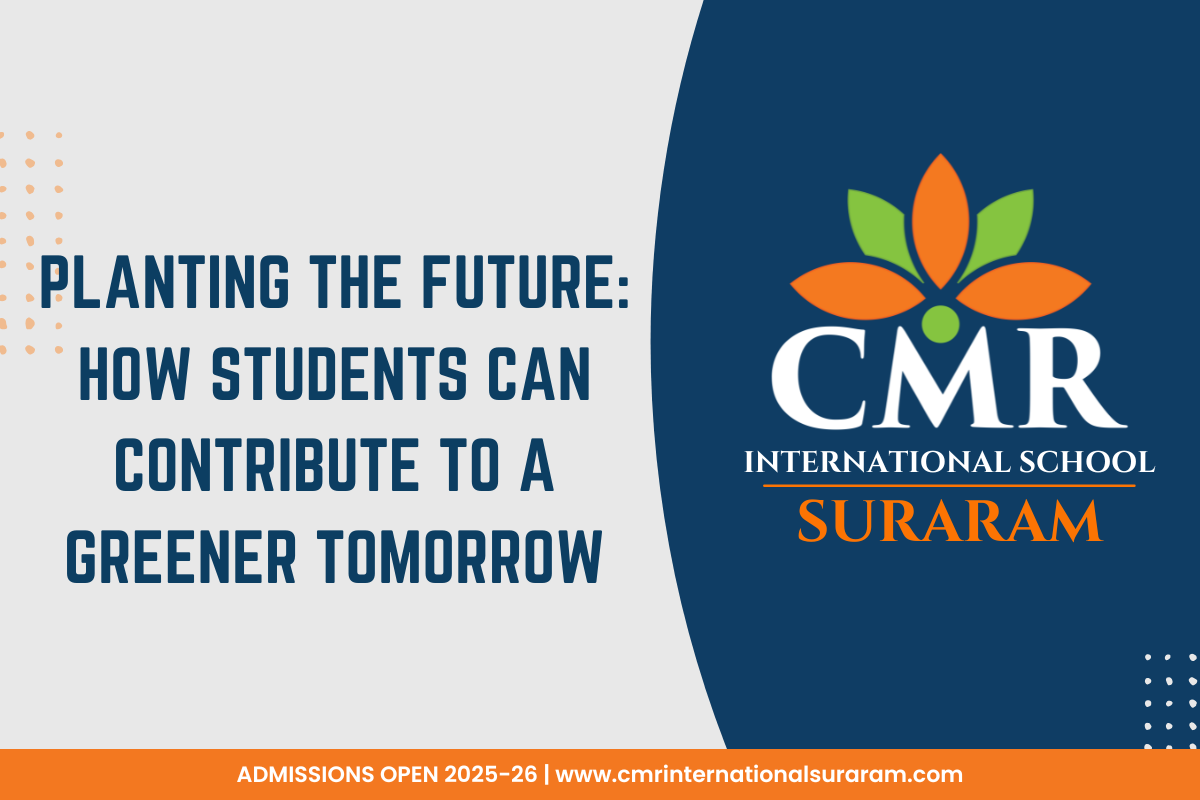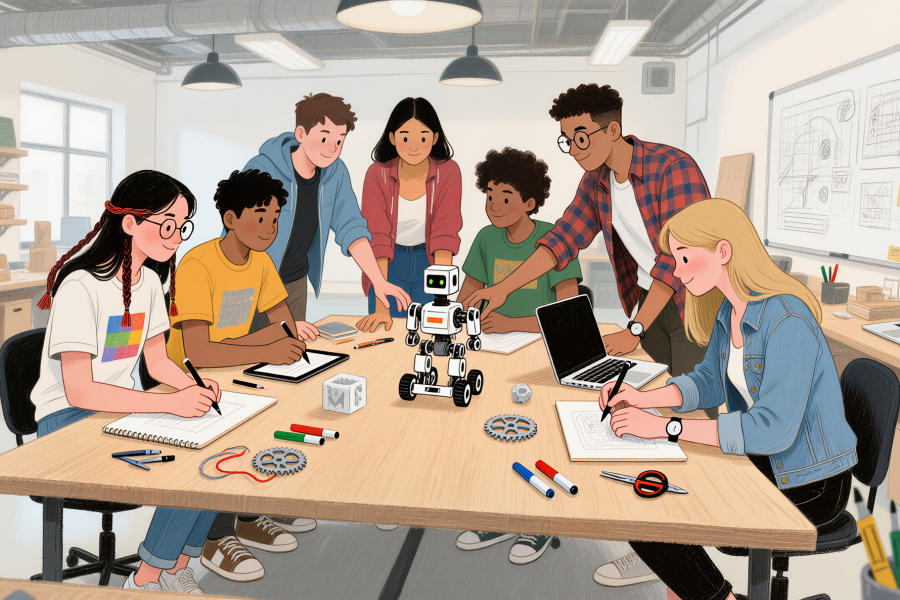Introduction
Have you ever watched a child plant a tiny seed and wait patiently for it to grow? That simple act holds the power to change the world. At CMR International School, Suraram, we believe that sustainability begins with education—and students are the most powerful agents of change.
In an age where climate change and environmental issues demand attention, teaching students to care for the Earth is no longer optional—it’s essential. Through hands-on learning, awareness campaigns, and green initiatives, we empower our learners to plant not just trees—but hope, awareness, and action for a better tomorrow.
Table of Contents
| Sr# | Headings |
|---|---|
| 1 | Why Sustainability Matters in Education |
| 2 | Teaching Environmental Values from an Early Age |
| 3 | Green Classrooms: What We Practice at CMR Suraram |
| 4 | Gardening as a Learning Experience |
| 5 | Tree Plantation Drives and Eco Clubs |
| 6 | Waste Management and Recycling Programs |
| 7 | Water Conservation Activities |
| 8 | Energy Awareness: Little Habits, Big Impact |
| 9 | Role of Students as Environmental Ambassadors |
| 10 | Nature Walks and Outdoor Learning |
| 11 | Creative Projects for Climate Action |
| 12 | Celebrating Green Events like Earth Day and Van Mahotsav |
| 13 | Involving Families in Going Green |
| 14 | How These Habits Shape Responsible Citizens |
| 15 | Our Vision for a Sustainable Future |
1. Why Sustainability Matters in Education
Environmental challenges are not just adult problems—they’re everyone’s responsibility, and children must be part of the solution. When schools teach sustainability, they don’t just share knowledge—they build lifelong habits and values that shape thoughtful, responsible citizens.
2. Teaching Environmental Values from an Early Age
At CMR Suraram, we begin eco-education in the primary grades. Through storytelling, nature crafts, and interactive activities, young learners grasp simple but powerful ideas—save trees, don’t waste water, recycle more. It’s never too early to plant the seeds of care and responsibility.
3. Green Classrooms: What We Practice at CMR Suraram
Our classrooms are more than just spaces for learning—they are models of green living. We encourage:
- Minimal paper usage
- Digital learning tools
- Proper waste segregation
- Use of eco-friendly supplies
We believe that teaching sustainability begins with doing it ourselves.
4. Gardening as a Learning Experience
There’s nothing quite like getting your hands in the soil. Our school gardens are student-run, where children:
- Grow vegetables and herbs
- Learn composting
- Understand the science of soil and photosynthesis
It’s biology, teamwork, and environmental care—all in one activity.
5. Tree Plantation Drives and Eco Clubs
Our Eco Club is one of the most active student groups. Members lead tree-planting campaigns, care for saplings, and monitor the campus greenery. Through these activities, students feel a sense of ownership and pride in their contribution.
6. Waste Management and Recycling Programs
“Don’t throw it—rethink it.” That’s the motto behind our 3R (Reduce, Reuse, Recycle) initiatives. Students are involved in:
- Recycling paper and plastics
- Reusing craft materials
- Organizing waste awareness campaigns
- Conducting audits on school waste
It’s a fun and practical way to understand resource conservation.
7. Water Conservation Activities
From rainwater harvesting models to “turn off the tap” campaigns, CMR students are actively engaged in water conservation. Through DIY projects and posters, they learn about the water crisis and ways to use every drop wisely.
8. Energy Awareness: Little Habits, Big Impact
We teach our students that even small acts—like turning off unused lights or using fans instead of ACs—can make a big difference. Our Energy Monitors program lets students track and reduce classroom electricity usage, giving them real-time impact tracking.
9. Role of Students as Environmental Ambassadors
Students take part in community outreach where they speak to local residents about eco-practices, organize street plays, and lead green walks. These young changemakers are setting examples for others and building leadership skills along the way.
10. Nature Walks and Outdoor Learning
Learning isn’t limited to the classroom. Through guided nature walks, bird-watching sessions, and outdoor science labs, our students learn to appreciate and protect biodiversity—not just study it in textbooks.
11. Creative Projects for Climate Action
We encourage students to think globally, act locally. Projects include:
- Making climate action posters
- Creating documentaries on environmental topics
- Conducting surveys on pollution in their neighborhood
- Building solar-powered prototypes
These activities help them connect real-world issues with real-world solutions.
12. Celebrating Green Events like Earth Day and Van Mahotsav
CMR Suraram celebrates all major environmental days with enthusiasm. Students participate in:
- Plantation drives
- Eco parades
- Green pledge ceremonies
- Art and poetry contests on nature
It’s not just celebration—it’s action with meaning.
13. Involving Families in Going Green
We believe sustainability is a team effort. That’s why we involve parents in:
- Family plantation programs
- Eco-friendly home challenges
- Reuse-and-recycle drives
When green habits are practiced both at school and home, they become a way of life.
14. How These Habits Shape Responsible Citizens
By participating in green activities, students develop:
- Empathy for nature
- Awareness of global challenges
- Confidence in taking action
- Responsibility towards their community
These are not just environmental traits—they’re citizenship traits.
15. Our Vision for a Sustainable Future
At CMR International School, Suraram, we envision a future where every student not only understands sustainability but lives it. From classrooms to communities, our students are ready to be guardians of the Earth.
Together, we are not just planting trees—we’re planting a better tomorrow.
Conclusion
Sustainability isn’t a trend—it’s a responsibility. And there’s no better time to start than now, no better place than school, and no better people than young learners.
At CMR International School, Suraram, a Top School in Hyderabad, we’re nurturing a generation that doesn’t just dream of a greener world—they work towards it. Every action counts. Every student matters. And every seed sown today is a promise for tomorrow.
FAQs
1. What age do students start learning about the environment at CMR Suraram?
Environmental education starts right from primary school through activities and interactive lessons.
2. Do students participate in real eco-activities, or is it only theory?
Students are actively involved in gardening, recycling, plantation drives, and environmental campaigns.
3. How does CMR promote eco-awareness beyond school hours?
Through family challenges, at-home green tasks, and parent-student events promoting eco-habits.
4. Are there specific clubs for students interested in environmental issues?
Yes! Our Eco Club leads all major green projects and campaigns on campus.
5. What makes CMR Suraram one of the top schools for sustainability education?
We blend academics with real action—ensuring students learn, apply, and lead environmental initiatives.



